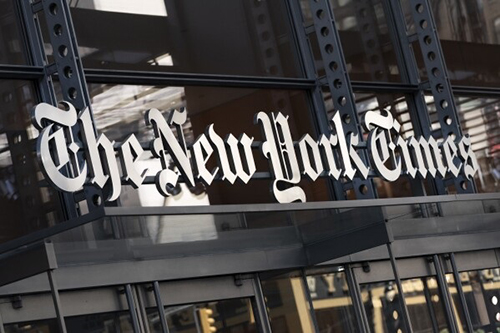|
Getting your Trinity Audio player ready...
|
By: Fern Sidman
A recent analysis conducted by a Yale professor found that The New York Times systematically downplayed Israeli losses following Hamas’s Oct. 7, 2023, terrorist invasion of Israel and minimized Palestinian violence in its reporting. The findings, which were published last month, add to growing concerns over media bias in the portrayal of Israel and the Gaza war, as reported by Algemeiner.com on Tuesday.
The study, led by Edieal Pinker, a professor and deputy dean at the Yale School of Management, examined a broad dataset of 1,561 articles published by The New York Times between Oct. 7, 2023, and June 7, 2024. According to the information provided in the Algemeiner.com report, Pinker’s analysis revealed a dominant editorial narrative in which Israel was largely depicted as the aggressor, while Palestinian suffering was emphasized. The study concluded that the coverage failed to provide readers with a balanced understanding of the war and its impact on Israeli civilians.
According to the report at Algemeiner.com, Pinker’s research scrutinized how The New York Times framed the ongoing war, identifying significant disparities in coverage between Israeli and Palestinian suffering. The study found that a staggering 70 percent of the articles adhered to a dominant editorial framework that emphasized Israel’s military actions in Gaza while downplaying or omitting key facts related to Israeli casualties, Hamas’s role in perpetuating violence, and the suffering of Israelis post-Oct. 7.
Pinker stated that the net result of these imbalances was a portrayal of the war that tilted heavily toward creating sympathy for the Palestinian side while placing most of the responsibility for the conflict on Israel. As reported by Algemeiner.com, nearly half of the articles surveyed failed to mention the ongoing plight of Israeli hostages, and 41 percent did not reference Israeli casualties from Hamas’s initial attack at all.
The Yale study revealed startling gaps in The New York Times’ coverage, with 1,423 out of the 1,561 articles surveyed making no mention of Israeli casualties incurred after Oct. 7, as reported by Algemeiner.com.
This omission is particularly significant given the scale of Hamas’s violence, which included the brutal massacre of 1,200 Israeli civilians and the kidnapping of 251 hostages in the initial Oct. 7 attacks. As per the information contained in the Algemeiner.com report, the study cited data from the Armed Conflict Location & Event Data project, which recorded 364 Israeli soldiers and 34 civilians killed in combat after Oct. 7, alongside hundreds of Hamas-led attacks inside Israel and the West Bank.
Despite these documented Israeli losses, the study found that The New York Times published personal stories of Palestinian or Lebanese suffering nearly every other day while going far longer periods without mentioning post-Oct. 7 Israeli casualties.
Furthermore, the report at Algemeiner.com noted that the study found that Hamas’s responsibility for sustaining the conflict was significantly downplayed. Only 10 percent of the war-related articles mentioned Hamas combatant deaths, while just 18 percent referenced Palestinian violence after Oct. 7. By contrast, Israel was mentioned over three times as often as Hamas in articles focused on the war.
The findings of Pinker’s study have reinforced longstanding criticism that The New York Times editorial stance has been systematically hostile toward Israel. The Algemeiner.com report also indicated that critics have argued that the newspaper has frequently framed Israel as the belligerent party, while downplaying Palestinian violence and Hamas’s terror activities.
This clear cut bias has led to ongoing debates about how major Western media outlets cover the Israeli-Palestinian conflict, with some accusing outlets such as The New York Times of shaping public perception through selective reporting and omission of crucial facts. According to Algemeiner.com, this skewed coverage impacts global discourse on the conflict, potentially influencing public policy and diplomatic stances toward Israel.
The study’s findings, as outlined in the Algemeiner.com report, raise broader concerns about how media bias shapes public opinion and political decision-making regarding Israel and the war in Gaza. With Hamas continuing to hold hostages and launch attacks, critics argue that The New York Times’ editorial slant has contributed to misinformation and distorted the reality of the war.
The study suggests that readers of The New York Times may not receive a full or accurate picture of the Israeli experience of the war, with key facts omitted or underreported. This issue extends beyond journalism and into public debates over Israel’s military strategy, its right to defend itself, and the broader implications of Hamas’s role in the conflict.
Author and media critic Ashley Rindsberg, who has written extensively about The New York Times in his book “The Gray Lady Winked,” told Algemeiner.com that the study’s findings are entirely consistent with how the newspaper has framed the Israeli-Palestinian conflict for decades.
“The findings of the Yale study show that The New York Times is framing the current conflict in a way that’s very similar, and almost a template, to how it’s framed the Israel-Palestine conflict going back to the Second Intifada,” Rindsberg explained to Algemeiner.com.
During the Second Intifada (2000–2005), a period marked by suicide bombings and mass terror attacks targeting Israeli civilians, Rindsberg argued that The New York Times crafted a dominant narrative that positioned Israel as the primary aggressor and Palestinians as perpetual victims. Algemeiner.com reported that the Yale study confirmed this same pattern in coverage of the current war—despite the fact that Hamas initiated the conflict with the brutal massacre of Israeli civilians on October 7, 2023.
Rindsberg pointed to the role of the Sulzberger family, which has controlled The New York Times for over a century, as a key factor in the newspaper’s editorial stance, as was noted in the Algemeiner.com report. He suggested that their ideological discomfort with Israel as a Jewish nation-state has shaped the paper’s approach to covering the conflict.
“The Times holds onto this narrative at all costs,” Rindsberg told Algemeiner.com. “The Sulzbergers are almost genetically opposed to the concept of Judaism that underlies the state of Israel, which is an ethnic and national conception of the Jewish people, not just a religious faith. For them, Israel completely disrupts their worldview, and the result is a culture at the newspaper that supports this kind of narrative.”
This deep-rooted ideological opposition, Rindsberg suggested, explains why The New York Times has repeatedly minimized Israeli suffering and framed Israeli self-defense as aggression, as reported by Algemeiner.com.
Despite these strong criticisms, Yale professor Edieal Pinker, the author of the study, cautioned that his research does not claim to “prove” bias in The New York Times’ reporting. Bias is difficult to quantify statistically, and assessing journalistic intent is even more complex.
Instead, Algemeiner.com reported that Pinker’s study sought to examine whether imbalances in reporting could shape public perceptions of the war in ways that distort reality. The study found that the disproportionate focus on Palestinian suffering, combined with the omission of Israeli casualties and Hamas’s role in perpetuating the war, had the effect of creating a one-sided view of the conflict.
One potential contributing factor, the study noted, was the vastly different levels of press access between Israel and Gaza. Israel generally allows journalists to operate freely, while Hamas exerts tight control over media coverage within Gaza. This restriction of independent journalism within Hamas-controlled territory could lead to unintentional biases in how the war is covered, favoring Hamas’s narrative, as was detailed in the Algemeiner.com report.
The study did not analyze the impact of other editorial decisions, such as photo selection, headline framing, or the tone of opinion pieces, all of which could further shape public perceptions.
In response to the study, The New York Times defended its coverage, claiming that its reporting provided “rich context, confronting truths, and horrific human stories” about the war, according to Algemeiner.com.
A spokesperson for the newspaper told Algemeiner.com that the Times had published over 13,000 articles, photos, and videos on the war, arguing that this extensive coverage demonstrated its commitment to journalistic integrity.
However, the Algemeiner.com report noted that The New York Times has long faced criticism from both supporters and opponents of Israel. While pro-Israel advocates argue that the paper consistently portrays Israel in a negative light, some anti-Israel critics claim that The Times is too sympathetic to Israel’s perspective. This ongoing debate over media bias remains a contentious issue, as major publications play a significant role in shaping global opinion on the conflict.
In response to the concerns raised by the Yale study and broader critiques of its coverage, The New York Times issued a statement defending its editorial decisions, as reported by Algemeiner.com.
“Our editors make careful and deliberate choices about every story we publish to ensure our language, framing, prominence, and tone remain true to our mission of independent journalism,” the spokesperson told Algemeiner.com.
The newspaper argued that its coverage is guided by a commitment to “independent reporting that our readers can trust”, rejecting allegations that it deliberately skews narratives to favor one side over the other. The New York Times also stated that it welcomes good-faith disagreements but will not adjust its coverage to align with entrenched perspectives.
Despite The New York Times’ defense of its reporting, the report at Algemeiner.com noted that prominent figures, including former Secretary of State Antony Blinken, have expressed frustration over the lack of coverage of Hamas’s role in the ongoing war.
In January 2024, Blinken addressed the media’s portrayal of the war, stating in an interview with The New York Times itself that the lack of focus on Hamas’s actions was “astounding.” According to Algemeiner.com, Blinken criticized the absence of widespread global condemnation of Hamas’s refusal to lay down its arms, release Israeli hostages, and cease hostilities.
“You hear virtually nothing from anyone since Oct. 7 about Hamas,” Blinken remarked. “Why there hasn’t been a unanimous chorus around the world for Hamas to put down its weapons, to give up the hostages, to surrender?” His remarks highlighted growing concerns that the media’s focus has been disproportionately centered on Israeli actions while failing to hold Hamas accountable for its role in perpetuating the conflict.
The New York Times’ assertion that it has covered the war with objectivity and rigor contrasts sharply with the findings of the Yale study, which found that the newspaper’s reporting overwhelmingly portrayed Israel as the aggressor while minimizing Hamas’s responsibility for the war, as per the Algemeiner.com report.
The debate over The New York Times’ coverage of the Gaza war remains highly contentious. While the newspaper insists that its journalism is independent, thorough, and fair, the Yale study’s findings, criticism from U.S. officials, and ongoing concerns over its editorial choices suggest that its reporting may not be as balanced as it claims.
With the war ongoing and global discussions about the Israeli-Palestinian conflict intensifying, media organizations such as The New York Times face increasing pressure to provide reporting that accurately reflects the full scope of the conflict. According to Algemeiner.com, the controversy surrounding the newspaper’s coverage calls attention to the critical role that media plays in shaping public understanding of complex geopolitical events—and the responsibility news organizations bear in ensuring fair and factual reporting.





